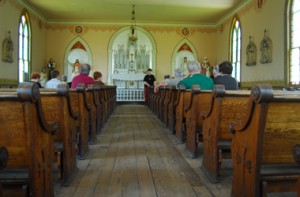At the edges of Pennsylvania’s coal region, the tiny village of Eckley, population 21, preserves the memory of a time and place that many immigrant families wished they could forget.
In the mid to late 1800s, the Irish, Welsh, Germans, and Slovaks from all over Eastern Europe worked side by side in the mines—dank, dark, and dangerous places where they could be killed at any moment by a cave-in or fire. If they were, their bodies were carried to their shanty, dumped on the front doorstep, and their widows were warned that if they didn’t find someone to work for them in 48 hours, they would be evicted from their company-owned homes. If a man survived the 12-hour days, the six-day work week deep below the earth, the coal dust imbedded in his lungs would take him before he was 50.
Boys as young as 9 and 10 worked as “breaker boys,” squatting over the conveyor lines filled with coal, cracking them into smaller pieces and winnowing out the slate. They were prone to a condition called “red top”—bleeding finger tips. Most had lost fingers before they were out of their teens.
The miners and laborers had to pay for their own tools and supplies, including lamps, picks, and explosives. Food and clothing was available at exorbitant prices at the company store. The rent on their homes was taken out of their $3 a- day-pay.
Into this picture came the Molly Maguires, a violent secret society, an outgrowth of the Ancient Order of Hibernians, that laid the foundation for the labor unions that eventually changed conditions for Pennsylvania’s miners. Though they were ultimately put down and their leaders hanged, they made their mark. And places like Eckley, with its social stratified layout (shantys for the laborers, larger homes for the miners, mansions for the owners) have become like fossils, preserved remains of a time when corporate greed brought unimagined misery to those who had fled thousands of miles from conditions they believed could not have gotten worse.
Eckley, purchased by the state of Pennsylvania in 1971 and now operating as a miners’ museum, has become a mecca not only for Irish and Irish-American history buffs, but for movie fans who love the romanticized version of life in Eckley in the Sean Connery movie, “The Molly Maguires,” filmed in the village in 1968. A group of young Irish immigrant footballers from Philadelphia appeared as extras in the film, including Vince Gallagher, president of the Commodore Barry Club (The Irish Center). Last Saturday (June 6), Gallagher and 50 other people made the trek from Philadelphia to Eckley and on to Jim Thorpe, where some of the Molly Maguires were held in the Carbon County Prison and hanged there in June 1871. It was Gallagher’s first trip back in more than 40 years.
In the movie, Gallagher was part of a scene in which the miners play a version of Gaelic football, using a round ball wrapped in what looked like rope. “It weighed about five pounds and you couldn’t throw it. It was more like a bowling ball,” Gallagher recalled. “Everyone went home with sprained fingers. They brought us in because they wanted to make it all look authentic, but it didn’t. And they shot the same damn scene 72 times.”
But the movie seemed to make less of a lasting impression on Gallagher than the shameful story of Eckley and other coal “patch towns,” where human beings were treated only slightly better than the mine mules who went blind and lost their hair because they spent their entire lives underground.
“I hope there’s a special place in hell for the mine owners,” said Gallagher, “and they burn there forever.”
Check out our photo essay, and learn more about the story of Eckley and the Molly Magures.

